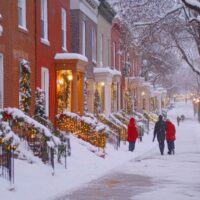NYC Administrative Code § 16-123: Removal of Snow, Ice, and Dirt from Sidewalks

Winter in New York City comes with its own set of challenges, not just for residents but also for property owners. One of the most significant responsibilities they face is complying with NYC Administrative Code § 16-123, which outlines the duties of property owners regarding snow, ice, and dirt removal from sidewalks. Failure to comply with these rules can lead to fines, additional expenses, and potential liability for injuries caused by hazardous conditions. New York premises liability attorney Leandros A. Vrionedes breaks down the key provisions of this law and explains its legal and practical implications.
Key Responsibilities of Property Owners
Under § 16-123, property owners, lessees, tenants, occupants, or anyone responsible for a building or lot adjacent to a paved sidewalk are required to:
Remove Snow and Ice Within Four Hours:
- Snow or ice must be removed within four hours after it stops falling.
- The timeframe excludes the hours between 9 PM and 7 AM. For example, if snow ceases at 10 PM, property owners have until 11 AM the following day to clear their sidewalks.
- This rule ensures timely removal of hazards without placing unreasonable burdens on property owners during nighttime hours.
Additional Time for Large Properties in Queens and Staten Island:
Owners of properties abutting 500 feet or more of paved sidewalk in Queens or Staten Island can begin clearing within the four-hour window and complete the task within a reasonable time.
Frozen Conditions:
- If snow or ice is frozen so hard that removal would damage the pavement, property owners may apply materials like sand, ashes, or sawdust to improve traction.
- Once the weather permits, the sidewalk must be thoroughly cleared.
Expense of New York City-Performed Removal:
If a property owner fails to comply, the city can step in to remove snow and ice. The cost of this removal is added to the owner’s annual taxes. The law also allows the city to pursue recovery of these expenses through legal action.
Penalties for Non-Compliance
The law imposes civil penalties for violations, which increase with repeat offenses:
- First Violation: A fine ranging from $10 to $150.
- Second Violation (within 12 months): A fine ranging from $150 to $250.
- Third or Subsequent Violations (within 12 months): A fine ranging from $250 to $350.
If the violator fails to respond to a notice of violation or summons, they may face additional penalties of up to $350 per violation.
Enforcement by the Environmental Control Board
Cases involving violations of this code are returnable to the Environmental Control Board (ECB), which has the authority to impose civil penalties. If violators fail to respond to summonses, they face further financial consequences, underscoring the importance of addressing violations promptly.
Specific Exemptions and Allowances
The code includes specific provisions to clarify exemptions and allowances:
- Owners of properties can throw snow or ice removed from sidewalks directly into the street, provided it is from the immediate area in front of their lot.
- The term “lot,” for enforcement purposes, is limited to a width of 25 feet fronting the street.
Practical Implications for Property Owners
Complying with § 16-123 is critical for property owners, as non-compliance can result in legal and financial consequences and liability for injuries sustained by pedestrians. Here are some best practices to ensure adherence to the law:
- Plan Ahead for Snow Removal: Have a snow removal plan in place, especially for large properties or those with significant foot traffic. This might include contracting with a professional snow removal service.
- Monitor Weather Conditions: Stay informed about snow forecasts to prepare for timely removal.
- Document Compliance: Keep records of snow removal efforts, including timestamps, photographs, and receipts for services or materials.
- Address Frozen Conditions Proactively: Use granular materials like salt or sand when snow cannot be immediately cleared to minimize hazards and comply with the law.
- Be Mindful of Special Circumstances: Owners in Queens and Staten Island managing large properties should ensure they start snow removal promptly and continue steadily to complete the task within a reasonable time.
Why This Law Matters
Sidewalk safety is a critical concern in NYC, especially during winter. Failing to remove snow and ice not only creates hazards for pedestrians but also exposes property owners to potential lawsuits for slip and fall injuries. While § 16-123 provides a clear framework for compliance, navigating the nuances of this law requires diligence and planning.
Contact Leandros A. Vrionedes, P.C.
If you’ve been injured in a snow or ice-related slip-and-fall accident, the experienced attorneys at Leandros A. Vrionedes, P.C. can help. Our team understands the intricacies of NYC Administrative Code § 16-123 and can guide you through the legal process to protect your rights. Contact us today for a free consultation.


